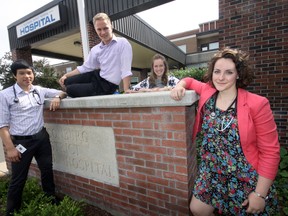Medical reality check

Article content
Angela Smith’s check on medical reality came last week in Tillsonburg District Memorial Hospital’s ER.
It’s immensely safe to say, she hadn’t arrived unprepared. One requires a rather high level of academic standing, not to mention a minimum four-year undergraduate degree to enter Western University’s school of medicine.
Once there, year one – of at least four for an MD degree and more if one chooses to specialize – features a veritable mountain of facts and theoretical work, backed up by guest appearances from standardized patients (SP), actors portraying diseases in as realistic a manner as possible.
Smith’s first indication she wasn’t in the classroom anymore, came as an accident victim requiring stitches arrived in the ER, and Dr. Bikash Chowdhury indicated she would be assisting him.
“It kind of hit me,” Smith recalled, “we are the ones who have to fix this.”
Four first-year Western med students enjoyed a productive, working four-day visit to Tillsonburg, arranged in conjunction with the South West Ontario Medical Education Network (SWOMEN). Its goals include exposing first-year students to rural medicine, and for the host hospital communities, its potential benefits. Its operation is very much hands on, a ‘great experience,’ said Rory Peca, who hails originally from Elmvale.
“It was the first real clinical experience we’ve had.”
Each member of a quartet also featuring Kyle Luong (from Scarborough) and Laura Rodger (Kingston, just across the 401 from Smith’s home in Sydenham) had their ‘moment’ during the four-day week. They ranged from something as seemingly simple as checking a real patient’s records for the first time, helping stitch up an accident victim, one’s first time in an operational OR (operating room) for an endoscopy, or the very real, poignant experience of being present and supportive in the palliative care area as an extended family gathered in the wake of a senior patient’s twin strokes.
And in those four short days in a working hospital with patients, rather than actors, all four realized their classroom efforts have a very real world application.
“This was…” mused Rodger.
“Real,” interjected Luong. “You realize what you took in school is real.”
“And useful,” Rodger continued. “We actually see it here, because the SPs are perfectly healthy, as Kyle said, here, it’s real.”
“This is a lot more tangible,” Smith agreed.
“This is what it looks like, looks like, this is what it sounds like,” Peca said.
He likened medical education to learning a new language, new words and proper usage.
“In school, it’s all this stuff, all this stuff and one test after another.”
Peca realizes another three years of intense classroom study and practical application are still there to help take what one might term rote translation into full fluency, but it was highly encouraging to discover contemporary medical professionals – ‘fluent’ in their craft – are at least on the same page.
“We can speak the same language – it was kind of cool.”
“We still have tons to learn,” added Rodgers, expanding on the same theory, while noting the four days were an indication there is a practical light at the end of their educational tunnel. “It kind of put it all together for us.”
Positive experiences within TDMH were mirrored in Tillsonburg itself, emphasized Smith, calling the opportunity “a real honour.
“Patients, citizens… everyone was interested and really welcoming and wanted to help us out in any way possible.”
And in the wake of a week of final first-year exams, a four-day working tour of duty proved a welcome relief, Peca concluded.
“The perfect way to end our first year,” he summed up.
“Maybe we’ll come back for Turtlefest,” Smith concluded with a smile.